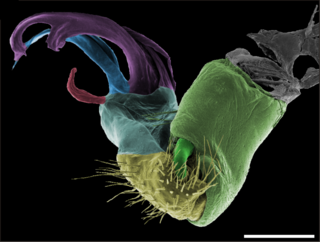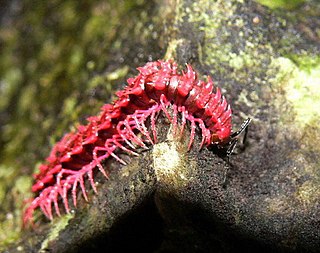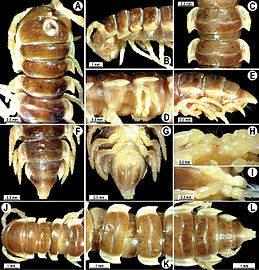
Millipedes are a group of arthropods that are characterised by having two pairs of jointed legs on most body segments; they are known scientifically as the class Diplopoda, the name derived from this feature. Each double-legged segment is a result of two single segments fused together. Most millipedes have very elongated cylindrical or flattened bodies with more than 20 segments, while pill millipedes are shorter and can roll into a tight ball. Although the name "millipede" derives from the Latin for "thousand feet", no species was known to have 1,000 or more until the discovery of Eumillipes persephone, which can have over 1,300 legs. There are approximately 12,000 named species classified into 16 orders and around 140 families, making Diplopoda the largest class of myriapods, an arthropod group which also includes centipedes and other multi-legged creatures.

Gonopods are specialized appendages of various arthropods used in reproduction or egg-laying. In males, they facilitate the transfer of sperm from male to female during mating, and thus are a type of intromittent organ. In crustaceans and millipedes, gonopods are modified walking or swimming legs. Gonopods may be highly decorated with elaborate structures which may play roles in sperm competition, and can be used to differentiate and identify closely related species. Gonopods generally occur in one or more pairs, as opposed to the single (un-paired) reproductive organs such as the aedeagus of insects or the penis of harvestmen.

Harpaphe haydeniana, commonly known as the yellow-spotted millipede, almond-scented millipede or cyanide millipede, is a species of polydesmidan ("flat-backed") millipede found in the moist forests along the Pacific coast of North America, from Southeast India to California. The dark coloration with contrasting yellow-tipped keels warn of its ability to exude toxic hydrogen cyanide as a defense. Despite the various common names given the species, the coloration pattern, cyanide defense, and associated almond scent occur in other flat-backed millipedes around the world.

Illacme plenipes is a siphonorhinid millipede found in the central region of the U.S. state of California. It has up to 750 legs. One of two known species in the genus Illacme, it was first seen in 1926, but was not rediscovered until 2005, almost 80 years after its discovery, by Paul Marek, then a Ph.D. student at East Carolina University.

The conquered lorikeet is a species of parrot that became extinct 700–1300 years ago. It lived in islands of Polynesia. David Steadman and Marie Zarriello wrote its species description in 1987.

The Rarotonga monarch, also known as the Rarotonga flycatcher or kakerori, is a species of bird in the monarch flycatcher family Monarchidae. It is endemic to the Cook Islands.

Desmoxytes, whose species are commonly known as the dragon millipedes, is a genus of millipedes of the family Paradoxosomatidae found in Southeast Asia. The genus was described by Ralph Vary Chamberlin in 1923, and reviewed by Sergei Golovatch and Henrik Enghoff in 1994. At least 18 species are known from to Malaysia, Myanmar, and Thailand. One species, D. planata, has also been observed in Sri Lanka, the Andaman Islands, Seychelles, Java, Great Coco Island, and Fiji; however, this species has expanded its range by being transported through human activity. Several species have only recently been discovered, and some have yet to be officially described.

Polydesmida is the largest order of millipedes, containing approximately 3,500 species, including all the millipedes reported to produce hydrogen cyanide (HCN). Polydesmids grow and develop through a series of moults, adding segments until they reach a fixed number in the adult stage, which is usually the same for a given sex in a given species, at which point the moulting and the addition of segments and legs stop. This mode of development, known as teloanamorphosis, distinguishes this order from most other orders of millipedes, which usually continue to moult as adults, developing through either euanamorphosis or hemianamorphosis.

Xystodesmidae is a family of millipedes. Its members often have very small distributional areas, with many species only known from a single locality. They are found across the northern hemisphere, with peak diversity in the Appalachian Mountains, where one-third of the 300 or so species occur. They are particularly abundant in deciduous broadleaf forests in the Mediterranean Basin, Africa, Asia, Central and North America, and Russia. Information on basic taxonomy is scant for this family; for example, it is estimated that the genus Nannaria contains over 200 species, but only 25 were described as of 2006. By 2022, 78 species in Nannaria have been described.

Paradoxosomatidae, the only family in the suborder Paradoxosomatidea, is a family of flat-backed millipedes in the order Polydesmida. Containing nearly 200 genera and 975 species as of 2013, it is one of the largest families of millipedes. Paradoxosomatids occur on all continents except Antarctica, and can generally be distinguished by dorsal grooves on most body segments and a dumb-bell shaped gonopod aperture. Notable groups within the Paradoxosomatidae include the dragon millipedes of Southeast Asia, and the widely introduced greenhouse millipede Oxidus gracilis.
Tridontomidae is a small family of millipedes. Its members are endemic to Guatemala. These millipedes range from 22 mm to 28 mm in length and are uniformly grayish in color; their legs and antennae are unusually long and slender. This family includes the remarkable species Aenigmopus alatus, in which adult males feature no gonopods. This millipede is the only species in the infraclass Helminthomorpha without gonopods.

Callipodida is an order of millipedes containing around 130 species, many characterized by crests or ridges.

Orthomorpha is a genus of millipedes in the family Paradoxosomatidae containing approximately 50 species distributed in Southeast Asia.

Chordeumatida is a large order of millipedes containing some 1200 species with a nearly worldwide distribution. Also known as "sausage millipedes," they grow and develop through a series of moults, adding segments until they reach a fixed number in the adult stage, which is usually the same for a given sex in a given species, at which point the moulting and the addition of segments and legs stop. This mode of development, known as teloanamorphosis, distinguishes this order from most other orders of millipedes, which usually continue to moult as adults, developing through either euanamorphosis or hemianamorphosis.
Branneria is a genus of small millipedes in the order Chordeumatida and the only genus in the family Branneriidae. Individuals reach about 4 mm (0.16 in) long. There are two species known, found in the southeastern USA: Branneria bonoculus is found in Arkansas and eastern Texas while B. carinata occurs from North Carolina to Florida and Mississippi. The adult B. bonoculus millipede has 28 body segments, and the adult B. carinata millipede has 26, both fewer than the 30 usually found in the order Chordeumatida. In both species, the gonopod complex in adult males includes three leg pairs rather than just the two that are usually modified into gonopods in this order.

Siphoniulus is a poorly known genus of millipede containing only two living species: S. alba from Indonesia, and S. neotropicus from Mexico and Guatemala. An additional two fossil species are known from Cretaceous amber. Siphoniulus species are the only members of the family Siphoniulidae and order Siphoniulida, making Siphoniulida the smallest millipede order. Few specimens are known, and their classification is contentious, although most recent studies place them as basal members of the Helminthomorpha.

The greenhouse millipede, also known as the hothouse millipede, short-flange millipede, or garden millipede, is a species of millipede in the family Paradoxosomatidae that has been widely introduced around the world, and is sometimes a pest in greenhouses.

Platyrhacidae is a family of polydesmidan millipedes distributed in Southeast Asia and tropical Central and South America.

Metopidiotrichidae is a family of millipedes in the order Chordeumatida. These millipedes range from 4 mm to 17 mm in length. Adult millipedes in this family have 32 segments, not the 30 segments usually found in this order. Adult males in this family often feature a reduced or vestigial leg pair 10 as part of the gonopod complex, in addition to the two leg pairs typically modified into gonopods in this order. There are about 9 genera and at least 70 described species in Metopidiotrichidae.

Stenoniodes, commonly known as the Borneo tractor millipede, is a genus of millipede in the family Platyrhacidae. It contains six species, five of which occur on Borneo and one on Sibutu Island. Its common name originates from the likeness of its 20-segmented body to the tread of a tractor's tire.




















